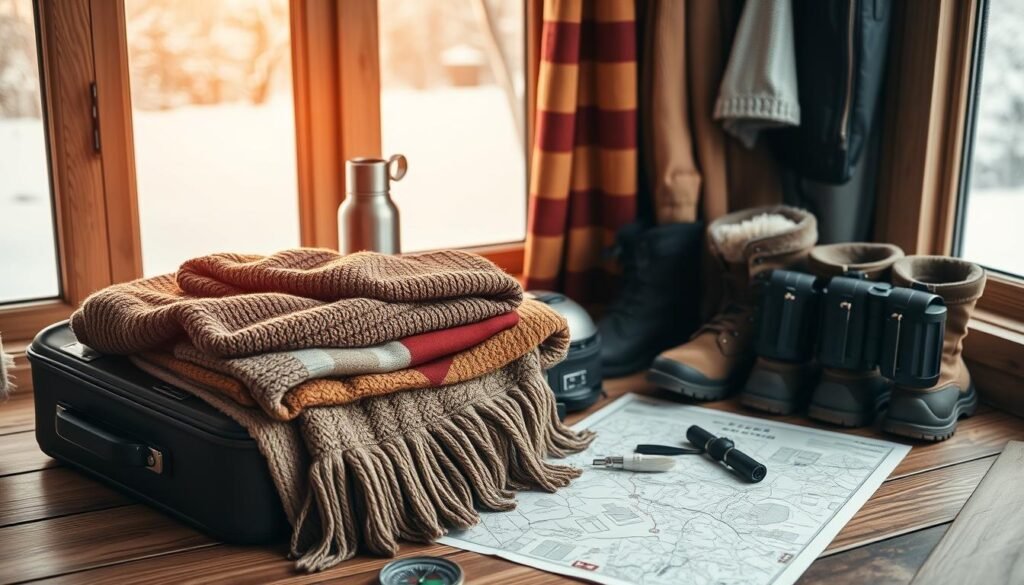As winter comes, many of us can’t wait to start cold weather adventures. But packing for winter travel can feel overwhelming. The secret to a worry-free trip is packing light while keeping the must-haves.
When packing for cold weather, think carefully to be ready for anything. Choose clothes that can be layered and key accessories. This way, you can have fun without carrying too much.
Key Takeaways
- Understand the importance of packing light for winter travel.
- Learn how to choose the right cold weather clothing.
- Discover strategies for efficient winter travel packing.
- Find out how to pack versatile clothing for varying conditions.
- Explore tips for avoiding overpacking during winter travels.
The Winter Travel Packing Challenge
Packing for winter travel has its own set of challenges. Winter clothes are bulkier and heavier than summer clothes. This makes it hard to fit everything into one suitcase.
Why Winter Clothing Takes Up More Space
Winter clothes like coats, sweaters, and boots take up more space. They are bulkier, making it tough to pack efficiently. This is even harder if you’re trying to fit everything into a carry-on.
The Cost of Overpacking in Winter
Overpacking can lead to extra fees for checked bags and overweight luggage. The International Air Transport Association says the average cost of checking a bag is about $30. Overweight fees can be from $50 to $200.
| Airline Fee Type | Average Cost |
|---|---|
| Checked Bag | $30 |
| Overweight Fee | $50-$200 |
Setting Realistic Packing Goals
To avoid overpacking, setting realistic goals is key. Choose versatile, layered clothing that can be mixed and matched. This way, you can create multiple outfits.
“The key to packing lightly for winter travel is to focus on layers and versatile pieces that can be dressed up or down.” –
By doing this, you can enjoy your winter trip without the hassle of too much luggage.
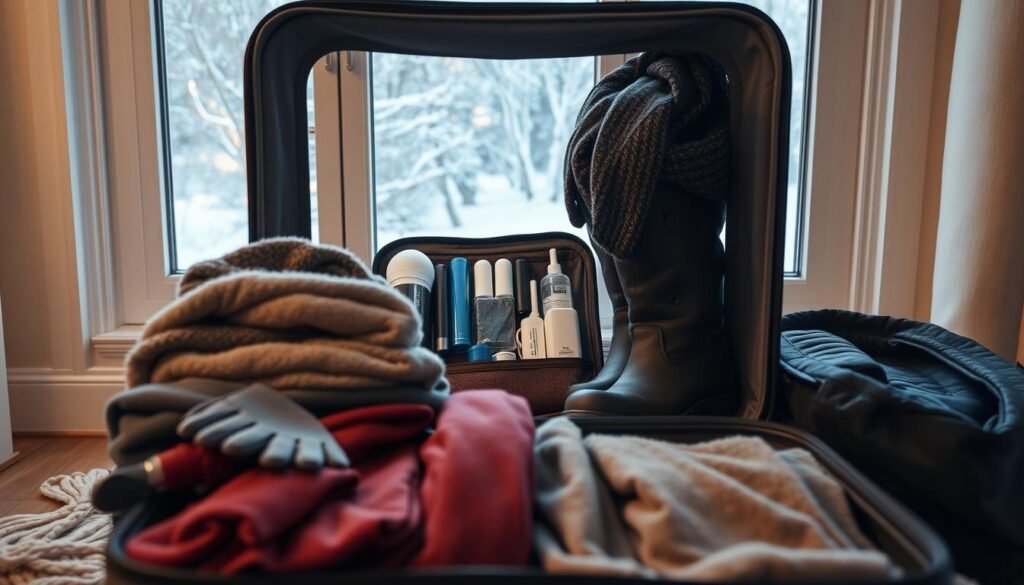
Planning Your Winter Wardrobe Strategy
To pack lightly for winter travel, you need a solid wardrobe strategy. It should balance warmth with versatility.
Research Your Destination’s Climate and Activities
Knowing the climate and activities at your destination is key. Research the average temperature and weather to choose the right clothes.
The Science of Layering for Warmth
Layering is a smart way to stay warm without packing too much. Wear multiple layers that you can adjust as needed. Start with a moisture-wicking base layer, add insulation in the middle, and finish with a wind-resistant outer layer.
Creating a Versatile Capsule Wardrobe
A capsule wardrobe has a few pieces that can be mixed and matched. This is perfect for winter travel, as it keeps your style without bulk.
Color Coordination Tips
Choosing a color palette makes mixing outfits easier. Stick to neutrals like black, navy, and gray. Then, add brighter colors for variety.
Multi-Purpose Garment Selection
Choose clothes that can be used in different ways. A scarf can be a blanket on a plane. A dress can be dressed up or down with leggings.
| Garment | Primary Use | Secondary Use |
|---|---|---|
| Scarf | Neck Warmth | Blanket/Picnic Mat |
| Dress | Outdoor Activity | Dinner/ Evening Wear with Leggings |
| Base Layers | Cold Weather | Layering for Indoor Activities |
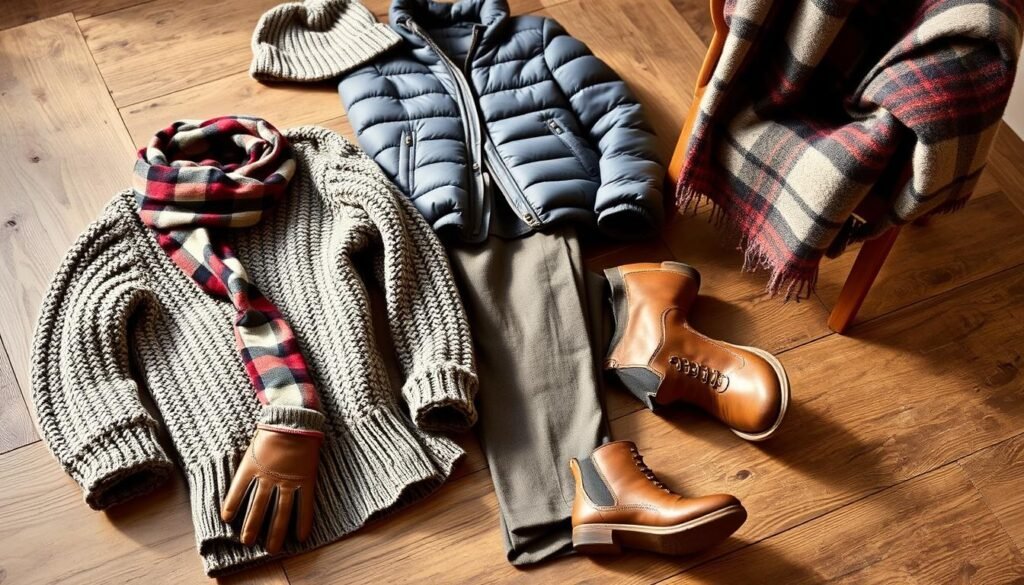
Essential Winter Clothing Items to Pack
When traveling in winter, it’s key to pack smart. Choose clothes that are warm but not too heavy. The right clothes can make your trip more comfortable and flexible, no matter the weather.
Base Layers: Your First Defense Against Cold
Base layers are vital for keeping warm. Pick moisture-wicking fabrics like merino wool or synthetic materials. These keep you dry and warm by pulling sweat away from your skin.
Mid-Layers for Insulation Without Bulk
Mid-layers add warmth without being too heavy. Choose lightweight, breathable materials that don’t bulk up. Fleece jackets or sweaters are great options.
Outer Shells and Weather Protection
Outer shells shield you from wind, rain, and snow. Go for waterproof and windproof materials like Gore-Tex. This keeps you dry and safe.
Winter Accessories That Pack Small but Deliver Big
Accessories like gloves, hats, and scarves are big on function but small in size. They’re light, easy to carry, and can be mixed and matched for different weather.
Gloves and Hand Protection
Gloves are crucial for keeping your hands warm. Choose waterproof gloves with a good grip to avoid dropping things. For really cold weather, pick insulated gloves that work with touchscreens.
Hats, Scarves, and Neck Warmers
Hats, scarves, and neck warmers are versatile. They can be worn together to keep you warm. Look for breathable, moisture-wicking materials.
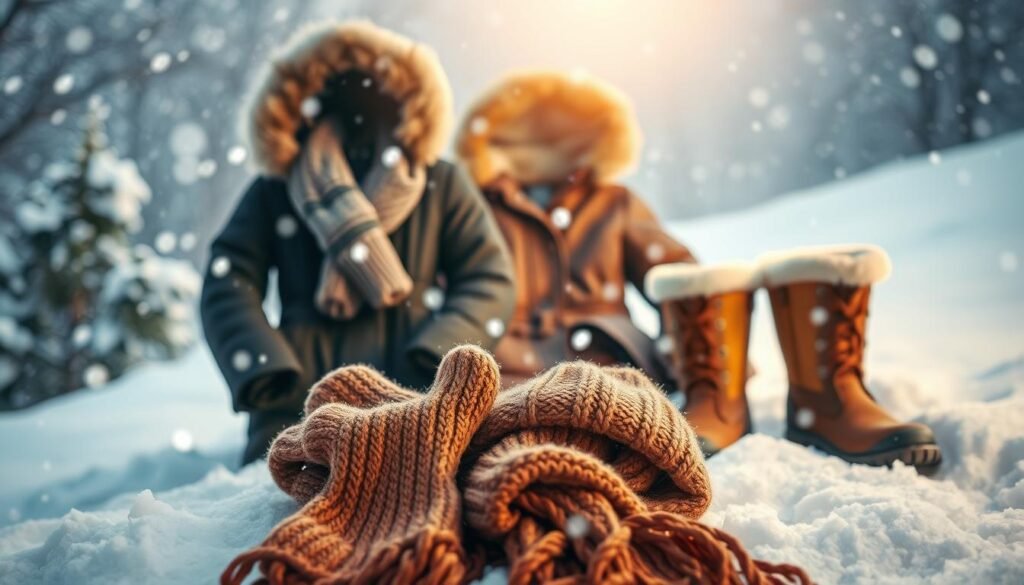
| Clothing Item | Material | Benefits |
|---|---|---|
| Base Layers | Merino Wool/Synthetic | Moisture-wicking, warm |
| Mid-Layers | Fleece | Lightweight, insulating |
| Outer Shells | Gore-Tex | Waterproof, windproof |
How to Prep for Winter Travels without Overpacking
Packing smart is key for winter travel. It’s not about how much you pack, but how well. A few clever strategies can make your trip lighter and more enjoyable.
The 5-Day Winter Packing Formula
Start with a 5-day packing formula. Choose a few versatile, quality items. These can be mixed and matched for different outfits.
Mix-and-Match Clothing Strategies
Mix-and-match clothing is a must for packing. Pick items that layer well and can be paired in many ways. A few tops, bottoms, and outer layers can make many outfits.
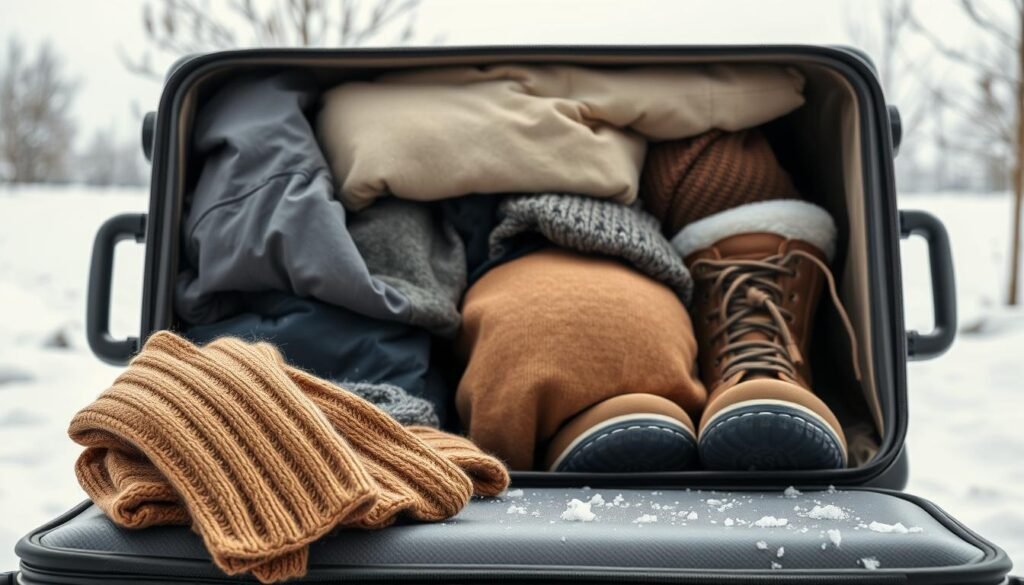
Wear Your Bulkiest Items During Transit
Wear your biggest items, like coats and boots, when traveling. This saves space and weight in your luggage. It’s a smart way to pack lighter.
Laundry Options During Extended Winter Trips
For longer trips, think about laundry options. Hotels often have laundry services, or you can use a local laundromat. Travel-sized laundry detergent is handy for washing in your hotel sink.
| Laundry Option | Convenience Level | Cost |
|---|---|---|
| Hotel Laundry Service | High | Moderate to High |
| Local Laundromat | Moderate | Low |
| Hand Washing in Hotel Sink | Low to Moderate | Low |
With these tips, you can travel in winter without the burden of too much luggage. Whether you’re off to the mountains or a chilly city, smart packing makes your trip better.
Space-Saving Packing Techniques
To make the most of your winter travel, it’s key to use space-saving packing techniques. Packing smartly not only cuts down on travel stress but also makes your trip more fun.
Rolling vs. Folding for Winter Clothes
There’s a big debate on whether to roll or fold your clothes. Rolling your winter clothes can reduce wrinkles and save space. But, folding might be better for bulky items to avoid creases.
Compression Bags and Packing Cubes
Compression bags are a big help for winter travel. They let you compress your clothes to use your luggage space better. Packing cubes help organize your stuff and make it easier to find what you need.
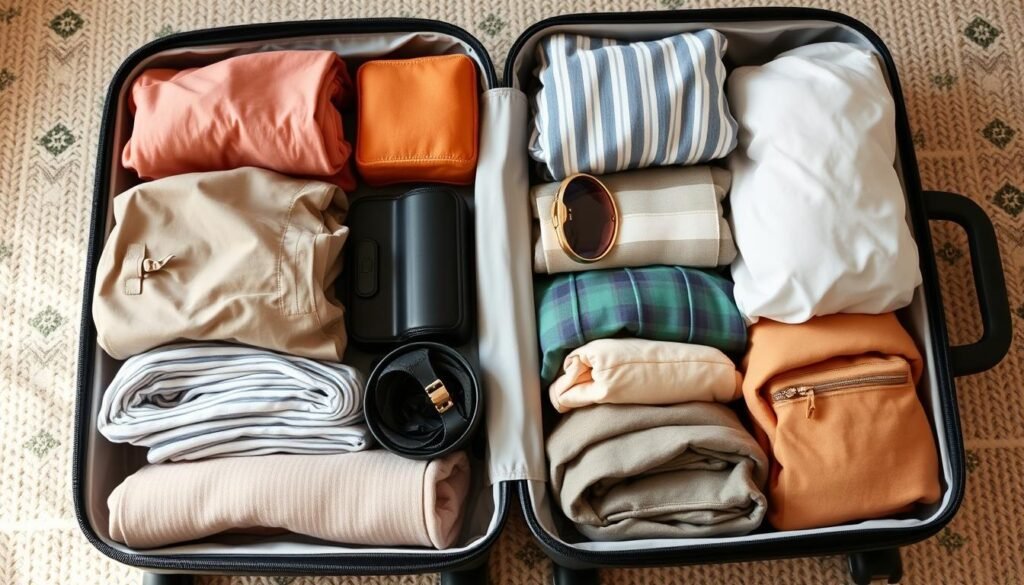
The Bundle Wrapping Method for Bulky Items
The bundle wrapping method wraps bulky items like sweaters or jackets around other clothes. This method protects delicate items and uses your luggage space well.
Strategic Placement in Your Luggage
Putting items in your luggage in a smart way can really help. Heavier items go at the bottom, and lighter ones on top. Use every bit of space, including pockets in your clothes and any gaps in your luggage.
| Packing Technique | Benefits |
|---|---|
| Rolling Clothes | Reduces wrinkles, saves space |
| Compression Bags | Compresses clothing, maximizes luggage space |
| Packing Cubes | Organizes belongings, easy to find items |
Smart Fabric Choices for Winter Travel
Choosing the right fabric for winter travel is key to comfort and packing. The best fabrics keep you warm, last long, and are versatile. This makes your trip more fun.
Merino Wool: A Top Choice for Winter Travelers
Merino wool is top for winter travel. It’s warm, breathable, and wicks away moisture. Plus, it naturally fights off odors, perfect for long trips without laundry.
“Merino wool’s ability to regulate body temperature and manage moisture makes it an indispensable fabric for winter travelers.”
Synthetic Fabrics for Cold Weather
Synthetic fabrics like polyester and nylon are great for winter. They dry fast, last long, and can be made to resist wind or water. Choose ones with special treatments for cold and wet weather.
Down vs. Synthetic Insulation
| Insulation Type | Warmth | Weight | Wet Conditions |
|---|---|---|---|
| Down | Excellent | Lightweight | Loses insulating properties |
| Synthetic | Very Good | Generally heavier | Retains insulation when wet |
Avoiding Cotton and Other Pitfalls
Avoid cotton for winter travel. It’s not good when wet and absorbs moisture. Choose merino wool, synthetic, or blends for better cold-weather performance.

By picking the right fabrics, your winter travel clothes will be more comfortable and efficient. Whether it’s merino wool, synthetic, or a mix, you’ll enjoy a better trip.
Winter Footwear Solutions
When traveling in winter, picking the right shoes is crucial. You need them to be warm and dry. The right boots can be both a comfort and a challenge when packing.
Choosing Multi-Purpose Winter Boots
Choosing multi-purpose winter boots is essential. Look for boots that are waterproof, insulated, and have good grip. This way, they can handle icy surfaces well. Brands like The North Face and Sorel offer great options that are both functional and stylish.
Indoor Footwear Options
For indoor activities, pack lightweight indoor footwear like slippers or sneakers. They are easy to pack and keep your feet comfortable in hotel rooms or indoor spots.
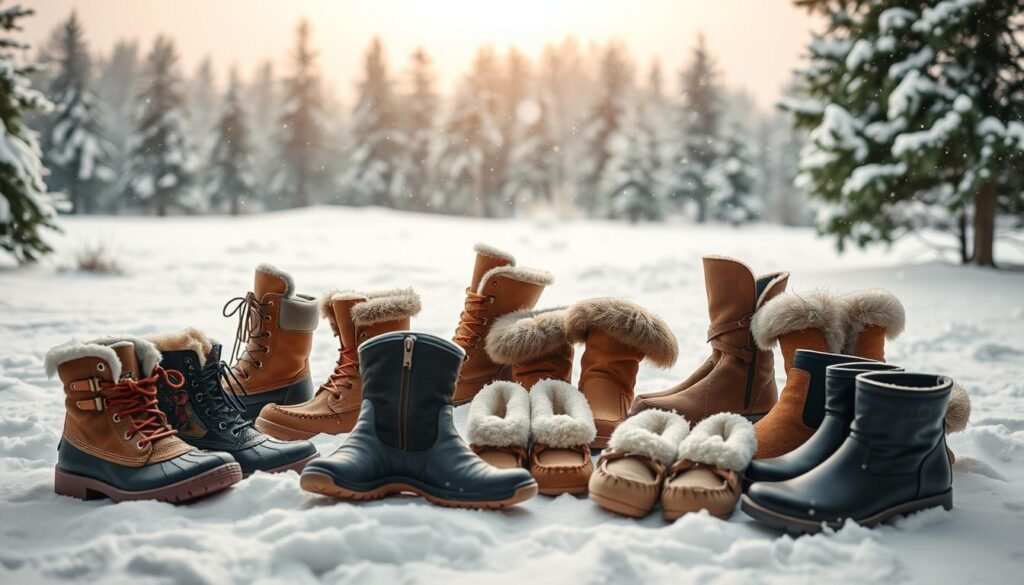
Packing Shoes Without Wasting Space
To save space, pack shoes smartly. Use shoe bags to keep them clean. Also, wear your bulkiest boots during travel to save luggage space.
Dealing with Wet Footwear While Traveling
If your shoes get wet, use newspaper or paper towels to dry them. There are also portable shoe dryers that can be very helpful.
| Footwear Type | Use Case | Packing Tip |
|---|---|---|
| Multi-purpose Boots | Outdoor Activities | Wear during travel |
| Lightweight Slippers | Indoor Activities | Pack in a small bag |
Tech and Toiletries for Winter Conditions
Traveling in winter means more than just wearing warm clothes. You also need the right tech and toiletries. Packing the right gadgets and personal care items is key for a comfortable trip.
Cold-Weather Skincare Essentials
Keeping your skin safe from winter’s harsh conditions is vital. Moisturizers and lip balms with SPF can prevent dryness and chapping. Don’t forget a hydrating serum to keep your skin moisturized. Look for products with:
- Hyaluronic acid
- Glycerin
- Ceramides
Electronics and Batteries in Cold Climates
Cold weather can hurt your electronics’ performance and battery life. Here are some tips:
- Keep your devices close to your body to keep them warm.
- Use insulated cases or covers for your gadgets.
- Carry portable chargers to ensure you have backup power.
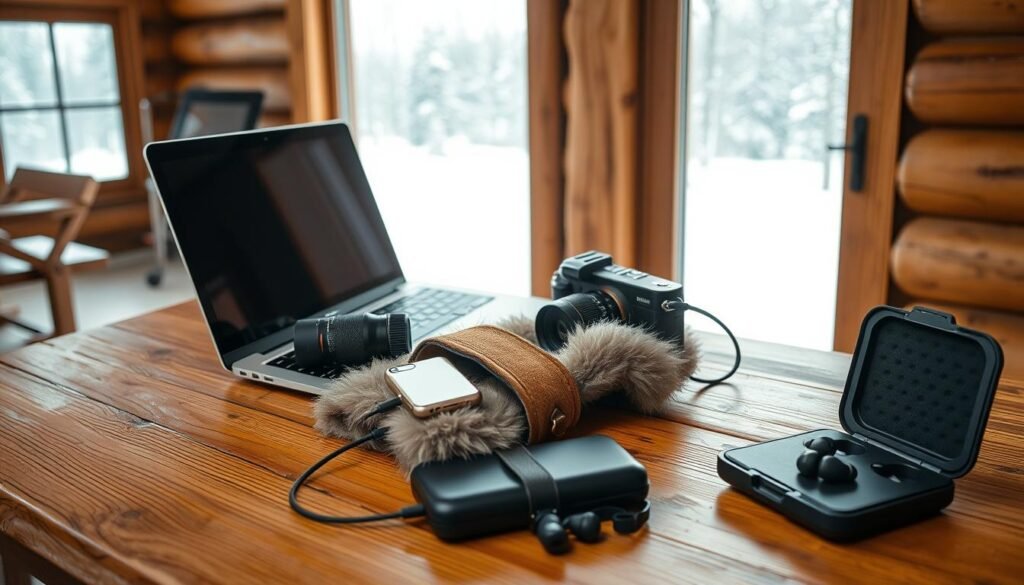
Medication and Health Considerations
Winter travel can bring health risks like cold and flu. Make sure to pack:
- Any personal medications
- Over-the-counter cold and flu medication
- Antiseptic wipes and hand sanitizer
Emergency Items Worth Their Weight
While packing light is important, some emergency items are worth it. Consider including:
- A first-aid kit
- A portable emergency blanket
- A backup power source for critical devices
Conclusion: Traveling Light in Heavy Weather
Traveling in winter doesn’t mean you have to carry a lot. With a few simple tips, you can enjoy your trip without heavy bags.
First, plan a versatile winter wardrobe. Include base layers, mid-layers, and outer shells. Use space-saving tricks like rolling clothes and compression bags to fit more in your luggage.
Choosing the right shoes is key. Pick multi-purpose winter boots. Also, pack shoes that go with many outfits. Remember to include smart fabrics like merino wool and synthetic materials for cold weather.
By following these tips, you’ll learn to travel light, even in harsh weather. Whether you’re off to the mountains or a chilly city, a smart packing plan makes your trip better.

